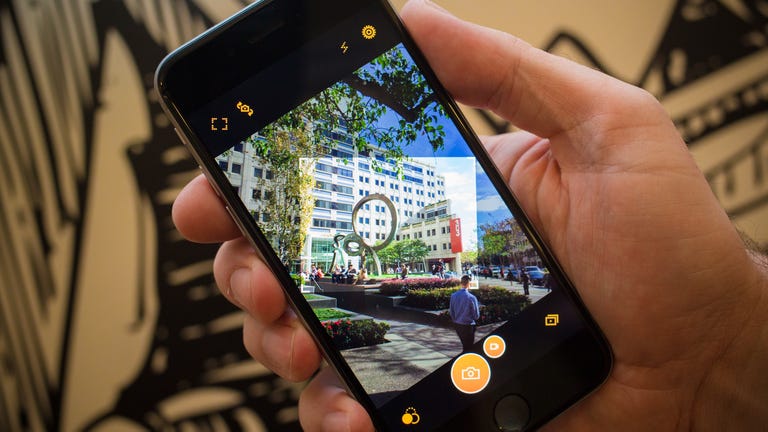 Why You Can Trust CNET
Why You Can Trust CNET Horizon review: Horizon helps you avoid embarrassing vertical videos
Horizon all but eliminates the possibility of accidentally recording a vertical video by shooting your video in landscape mode no matter how you hold the device.
Horizon (iOS|Android) is a photography app that makes you question why its functionality doesn't come built into your smartphone's operating system out of the box. It can replace the standard video-recording feature on your Android or iOS device, but with an additional twist.
The Good
The Bad
The Bottom Line
That twist is that it prevents you from ever recording video in portrait orientation, no matter how you hold your device. If you're not aware -- and really, you should be -- why vertical videos are not ideal, here are a few reasons. As humans, we are built to view the world in wide screen, hence our eyes are side-by-side rather than on top of each other. And if that's not enough, the big black bars that take up both sides of the screen when viewing a vertical video are distracting, annoying and ruin the view.
Horizon's solution is to take advantage of the gyroscope on your smartphone to rotate and crop video as your record it. The end result is a horizontal video that looks great, no matter how you hold your phone.
Setup
For the purpose of this review, I focused on the free Android version of the app. There is an iOS version, available for $1.99, £1.49 and AU$2.49, offering features such as selections for 120 and 60fps, 2K high resolution and a handful of filters not currently available to Android users.
There isn't a whole lot to Horizon on either smartphone, making initial setup a breeze. You're guided through a quick tutorial outlining how the app works, and the difference in modes. Don't worry if you swipe through the brief tutorial screenshots and miss something; you can always relaunch it from the app's settings.
With the free Android version, you can record clips of only 15 seconds in length while the iOS version is unlimited. The shortened Android clips also have a watermark in the lower corner, and each one ends with a brief splash screen advertising the app. The cost to unlock all features on Android currently sits at $1, so it's cheaper for Android users to unlock everything.
Capturing video
If you've recorded video on your smartphone in the past, you'll feel right at home when using Horizon. The biggest adjustment you'll need to make involves framing the video itself. When you hold your phone in vertical orientation, a small box will be placed in the middle of the screen. This box is your viewfinder. Meaning anything within this small box is what the app will record. The outlying areas of the screen still offer some transparency, but that's only to aid in helping you frame your video.
Three different modes
There are three different modes available when recording with Horizon. Each mode has a direct link to the orientation of your device, and whether or not you're rotating it while filming.
The default mode is called Flex. Using Flex the app will rotate the viewfinder as your rotate your device, keeping the video horizontal no matter how much you move. An added benefit of Flex mode is that it doubles as a digital zoom when you rotate your device. Holding your device in a landscape position will zoom out on the subject, capturing more of the surrounding area. Rotating the device vertically to a portrait position will zoom in on the subject. It's a neat effect that occurs simply because more can fit on the screen in landscape orientation.
Next up is a mode called Rotate. As the name implies, the viewfinder will rotate as you move your device, keeping the video the same size and zoom level no matter your device's orientation. The only benefit to using Rotate is it makes sure your video is horizontal, no matter how you hold your phone.
Last is Lock mode. When enabled, Lock will prevent the viewfinder from moving as you rotate your device.
After testing all three modes in various settings, I found each has its advantages depending on what I was recording. But at the end of the day, I suggest leaving Flex enabled and letting the device take care of everything for you. The added benefit of zooming in and out by rotating a device, along with the app constantly adjusting in an attempt to stabilize your video, makes Flex feel a little more like a sports TV camera that changes zoom as it captures the action.
It's great, but a little shaky
Even with Flex enabled, I would have liked to see more video stabilization features. As I rotated my device to test the various modes, the video quality suffered with consistent shaking. I'm sure some of it was due to how fast or slow I rotated the device. Still, it would be useful to see stabilization effects similar to those found in Instagram's Hyperlapse app.
By no means is it a deal-breaker, but it's something I would love to see improved upon. I should point out, the trembling was experienced on both a Moto X and an iPhone 6, eliminating any platform or device inconsistencies.
Conclusion
Despite the shaking that can occur when you rotate your smartphone, Horizon does exactly what it promises to do: eliminates vertical videos. The familiar interface makes it possible for nearly anyone to pick up and start using it without advanced tutorials or in-depth guides. The added zooming feature I mentioned in Flex mode is also a welcome surprise, adding something to your videos you didn't have before.
Horizon is a great, if somewhat flawed, tool without the stabilization features, but it's one I would love to see integrated at the OS level across both Android and iOS devices. The Internet deserves better than vertical videos.


